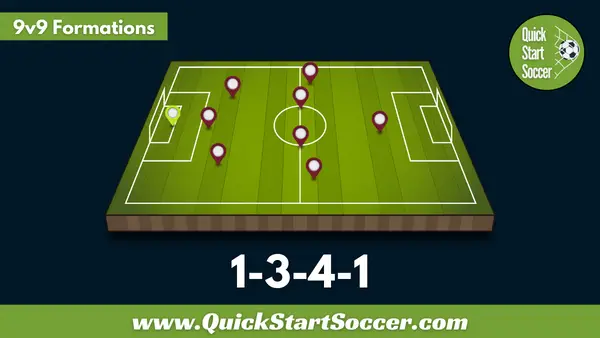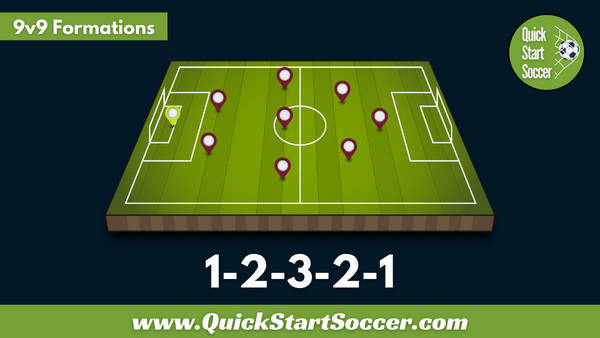Best 9v9 Formations For Your Team
9v9 formations are some of the more exciting formats for young players to play. Compared to 7v7 games, 9v9 soccer is played on a larger field with more numbers. As such, 9v9 play demands an improved level of spatial awareness from players as well as a greater understanding of specific player positions.
For both experienced and novice youth soccer coaches, understanding the different 9v9 formations you can use, as well as their strengths and weaknesses, is essential. And so, we have put together this guide detailing the best 9v9 formations for your team and the pros and cons of each of these formations. We’ll also let you know some important information about 9v9 soccer games, such as at what age players typically start playing 9v9, and the 9v9 soccer field dimensions.
When do players start playing 9v9?
In the U.S.A, children start playing 9v9 soccer in the U11 or U12 age group. This is largely consistent with many soccer or football-playing countries around the world. However, there are certain countries, such as Spain, that wait another year before progressing to this larger-sided format. The thinking behind sticking to smaller-sided games for longer is to provide even more touches on the ball and decision-making opportunities for players. Regardless, 9v9 is still the standard for most 10 and 11 years olds playing the game around the world.
How Big Is A 9v9 Field?
A 9v9 soccer field has the following dimensions: 45-55 yards wide and 70-80 yards long. These are not strict requirements, however, and the size of fields can differ from state to state. 9v9 fields have all the regular components of a 11v11 field but on a slightly smaller scale.
The field is split into two halves by a halfway line with a center circle in the middle. The center circle has an approximate radius of 8 yards. There are two penalty areas, one in each half, which are 14 yards long and 36 yards wide. The penalty spot is 10 yards away from the goal instead of 12, and there are small one-yard corner arcs in each corner of the field. The final thing to note is the goal size. For 9v9, goals should be 7 feet high and 16 feet wide. Learn more about Soccer Field Dimensions here.
Is There A Build Out Line In 9v9 Soccer?
There is no build-out line in 9v9 soccer. In fact, all rules that apply to the 11v11 game are included in the 9v9 format. This includes offside!
Best 9v9 Soccer Formations
Now that we’ve covered the basics of 9v9 soccer, it’s time to look at the best and most common 9v9 soccer formations.
The 1-3-2-3

The 1-3-2-3 is the ‘go-to’ 9v9 formation for the majority of coaches. From the back, this formation consists of 1 goalkeeper, 3 defenders (a left, a right, and a center), 2 central midfielders, a left and right winger, and a striker. The formation has a good spread of players across the field and provides strength in numbers in both defense and attack.
For coaches that lean towards a possession-based game, the 1-3-2-3 formation helps naturally put players in positions in which they can create good angles of support for the player on the ball. It’s also a very attack-minded formation, with the 3 forwards being able to cover the full width of the field.
One weakness of the 1-3-2-3 formation, however, is that it can be seen as being a little light in the midfield area with only 2 central midfielders. For this reason, coaches often look to people who are athletically blessed and comfortable on the ball in this position.
1-3-4-1

The 1-3-4-1 formation is remarkably similar to the 1-3-2-3. However, it puts a greater defensive demand on the two wide forwards by essentially classing them as left and right midfielders. In possession of the ball, the 1-3-4-1 morphs into the 1-3-2-3 as the outside midfielders push on to support the striker on either flank. When out of possession, those same players have to work back, defending the wide areas in the team’s middle and defensive thirds.
The 1-3-4-1 is a great formation for coaches that want to dominate in all areas of the field. This formation does, however, put a very high demand on those outside midfielders who are essentially doing two roles at once. As such, for teams who are not particularly strong athletically, it can be a tougher formation to play and succeed with.
1-2-3-2-1

Probably the most modern and possession-orientated 9v9 formation, the 1-2-3-2-1 is the perfect way to set your team up if you want to keep the ball from the first minute to the last! Consisting of 1 goalkeeper, 2 defenders, 3 defensive midfielders, 2 attacking midfielders, and 1 striker, this setup helps players create triangles and diamonds throughout the center of the field from back to front.
If you want to teach your team to keep the ball, pass and receive under pressure, and create good angles of support at all times, then this formation could very well be for you! The strength in numbers in the middle of the park gives teams the opportunity to dominate and possess the ball. It also sets them up defensively should they lose it.
In terms of weaknesses, critics would point to the general lack of width up top, which can make it harder to get behind stubborn defenses and break them down. There is also a risk of opposing teams achieving success by attacking wide areas, particularly in transition, which puts a greater demand on the right and left midfielders to track back and help their team defensively.
1-4-3-1

For the more defensive-minded coaches out there, the 1-4-3-1 formation offers the greatest stability and security when not in possession of the ball. By placing 4 defenders in the back line, coaches of this formation look to deny penetration by condensing the zone in front of the goal with 2 central defenders plus one to the right and one to the left.
The addition of 3 central midfielders means that teams are strong and can compete in this area too. Another strong advantage of this formation lies in the fact that the vast majority of 11v11 teams play with a back 4, so it can be a great opportunity for players to learn how to do this in the smaller 9v9 format. One of the main disadvantages is the difficulty teams may have to build the ball out of the back and create chances in the final third due to the lack of offensive players in the team.
More Formations
Thanks for reading! I hope your team has lots of success playing these different 9v9 formations. Before you go, be sure to check out these 7v7 formations and our huge library of free soccer drills for inspiration for your next soccer training sessions.

